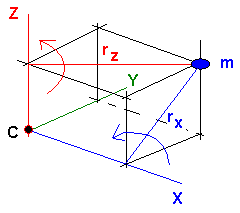Centrifugal and angular acceleration forces are static loads that consider added masses.
This type of load generates centrifugal and angular acceleration forces caused by element mass and masses added in nodes or elements. The following forces are generated:
- Centrifugal force for a given angular velocity V: Fr = m * v^2 * r.
- Force tangent to the direction of motion at the point of a given angular acceleration a: Ft = m * a * r, where r is a distance of a given mass node to the axis of the coordinate system at the central point of rotation. (See the following image.)

Parameters of this load type include:
- Coordinates of the rotation center point C (x, y, and z) - Coordinates of the rotation point can be defined graphically.
- Angular velocity and angular acceleration, which are defined by 3 components in the global coordinate system X, Y, and Z.
It is assumed that the orientation of the generated centrifugal force is directed outward from the central point. Generation of the tangent force orientation is consistent with the direction of rotation. That is, if a positive value of acceleration is defined, tangent forces are consistent with dextrorotatory rotation about a given axis.
This type of load can be applied to structure displacements on the sea caused by pitching and heaving of a ship or platform.
